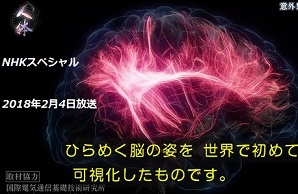
非論証的推論において非常に有用と思われたもうひとつの概念、即ち、「構造」 (structure) の概念がある。我々がある方向に赤を見、他の方向に青を見るとき、一方の方向に起っ ていることと他の方向に起っていることとの間には何らかの相違があると考える(推測する)ことは合理的であると思われる。従って、色の感覚(色を感じ取る能力)の外的原因は、感覚が色をもつのと同じ意味でそれ自身が色付けされてはいないと認めざるを得ないかも知れないけれども、それにもかかわらず、我々がいくつかの色のパターン(例:赤い色のパターン)を見る時、色の感覚を生み出す原因の中にも同様のパターンが存在するに違いない,ということになる(It follows that - 構造上の相似があるはず、ということ)。因果的に結合している事象の一つの系を通して、しばしば一定不変(remains constant)に維持される,あるいは,近似的に一定不変に維持されるものとしての時=空構造(space-time structure)という概念は、きわめて重要かつ実り多いものである。ごく簡単な例をとってみよう。(たとえば)Aがある本を音読し、Bがそれを聞いて書き取り、そうして、Aがその本の中に見たものはBが書きとったものと言語上一致している場合、次の4組の事象の間の因果的結合を否定することは全く不合理だろう。つまり、 (1) 本の中に印刷されているもの (2) Aによって音読される時に出る音(Aが発する音) (3) Bによって聞かれる音(Bが聞いた音) (4) Bの書いた語(群)(Bが書いた文字列) 同種のことが、蓄音機のレコードとそのレコードが生み出す音楽との間の関係についても当てはまる。あるいは、また、放送について考えてみると、そこでは、音が電磁波に変換され、電磁波は再び音に変換される。このとき、話された音と聞かれた音がよく似ているということは、(両者の中間に)介在する電磁波が、語られる語(文字列)の時=空構造と聞かれる語(文字列)の時=空構造とがきわめてよく似た構造をもっている(もっていた had had)のでなければ、不可能であろう。自然の中には、放送における音と電磁波との間の構造のように、(それぞれの)固有の性質の諸変化を通して(throughout 変化を貫いて)因果的に伝達される複雑な構造の無数の例が存在している。実際、視覚と聴覚は全て、(それぞれの)固有の性質ではなく,構造を伝達するという性質をもっている。(訳注:電磁波は音を伝えたり、熱を伝えたりするが、音と熱は異なったものであり(変化があり)、構造のみが同じように伝えられるということ )
現代論理学に親しみのない人は、時=空を構成する諸性質を知らずに時=空構造を知ることが可能であると推論することは困難だと思う。これ(時=空構造を知ること)は、知識のより広い側面の一部(一面)である。馬鹿げた逆説に自らを導きたくないならば、我々は「全てのAはBである」とか「あるAはBである」とかいう命題を、Aの個別的事例を示すことができなくても知ることは可能であるということを認めなければならないだろう。たとえば、「私が今まで考えたこともなく、これから考えることもない全ての数は、千より大きい」というような命題は否定できないものであるが、そういう数の個的事例を示そうと試みるなら自己矛盾に陥るであろう(訳注:例をあげれば「これから考えることもない全ての数」と矛盾してしまう。ある特定の故人が死ぬまでに考えたことのない数は必ずあることは明らか)。同様のことが、純粋に物理的な世界における時=空構造についてもあてはまる(適用できる)。(即ち、)物理的世界における構造の構成要素となっている諸性質が、感覚的経験において私の知るところの諸性質と何らかの固有の相似性をもつと考えなければならない理由は存在しないのである。
Chapter 16: Non-Demonstrative Inference , n.11 There is another conception which seemed to me of great utility in non-demonstrative inference, namely that of ‘structure’. It seems reasonable to suppose that, if you see red in one direction and blue in another, there is some difference between what is happening in the one direction and what is happening in the other. It follows that, though we may be compelled to admit that the external causes for our sensations of colour are not themselves coloured in the same sense in which our sensations are, nevertheless, when you see a pattern of colours, there must be a similar pattern in the causes of your sensations of colour. The conception of space-time structure as something which often remains constant, or approximately constant, throughout a series of causally connected events, is very important and very fruitful. Suppose, to take a very simple example, A reads aloud from a book and B takes down what he hears from dictation, and what A saw in the book is verbally identical with what B has written, it would be quite absurd to deny a causal connection between four sets of events — viz. (1) what is printed in the book, (2) the noises made by A in reading aloud, (3) the noises heard by B, and (4) the words written by B. The same sort of thing applies to the relation between a gramophone record and the music that it produces. Or, again, consider broadcasting, where sounds are transformed into electro-magnetic waves, and the electro-magnetic waves are transformed back into sound. It would be impossible for the spoken sounds and the heard sounds to resemble each other as closely as they do unless the intervening electro-magnetic waves had had a space-time structure very closely similar to that of the words, spoken and heard. There are, in nature, innumerable examples of complex structures transmitted causally throughout changes of intrinsic quality, such as those between sound and electro-magnetic waves in broadcasting. In fact, all visual and auditory perceptions have this character of transmitting structure but not intrinsic quality. People unaccustomed to modern logic find it difficult to suppose that we can know about a space-time structure without knowing the qualities that compose it. This is part of a larger aspect of knowledge. Unless we are to land ourselves in preposterous paradoxes, we shall find it necessary to admit that we may know such propositions as ‘all A is B’ or ‘some A is B’, without being able to give any instance of A — e.g., ‘all the numbers that I have never thought of and never shall think of are greater than a thousand’. Although this proposition is undeniable, I should contradict myself if I attempted to give an instance. The same sort of thing applies to space-time structure in the purely physical world, where there is no reason to suppose that the qualities composing the structure bear any intrinsic resemblance to the qualities that I know in sensible experience.
Source: My Philosophical Development, 1959, by Bertrand Russell
More info. https://russell-j.com/beginner/BR_MPD_16-10.HTM
